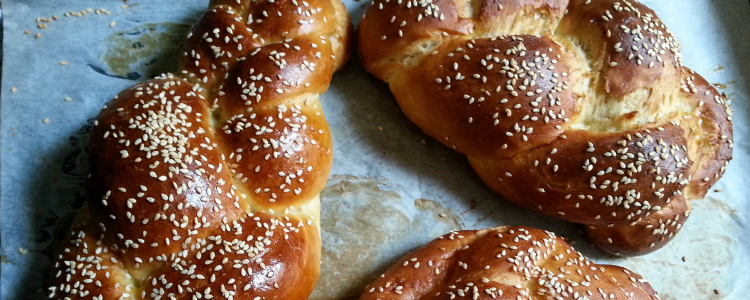Following Jewish Dietary Law in Recovery
This week, during Shabbat morning worship, Jews around the world will read the foundational laws of kashrut (Jewish dietary law) from the Torah. These laws are extensive and specific because they describe the species of land, air, and sea animals that are kosher. In the thousands of years since this first iteration of kashrut, Jewish legal authorities have interpreted and expanded upon the original rules. Today, kashrut is a system of procedures for harvesting, preparing, and serving food, which people follow with varying levels of strictness.
Kashrut has important benefits. It fosters a sense of Jewish peoplehood across space and time. It leads to the establishment of kosher restaurants, food pantries, and other institutions that serve Jews and non-Jews. It adds mindfulness and intentionality to the otherwise mundane act of eating.
However, for Jews like me who struggle with eating disorders, kashrut is a double-edged sword. The strict criteria that determine if food is kosher can feel similar to disordered food rules, because both involve the separation between foods that are “good” and “bad” or “allowed” and “forbidden.” Likewise, there are parallels between kashrut-related rituals — such as the elaborate process of preparing kosher meat — and disordered food rituals or compulsive behaviors. These factors (among many others) contribute to the higher-than-average rate of eating disorders within the Jewish community.
This is not to say that kashrut is inherently disordered. Many Jews keep kosher while practicing intuitive eating and maintaining healthy attitudes towards food and their bodies.
However, I know from personal experience that for people with eating disorders, kashrut is an easy tool to exploit.
I began observing kashrut almost five years ago, shortly after the first major flare-up of my eating disorder. I wanted to keep kosher for spiritual and communal reasons, but I quickly discovered that the stricter my observance of kashrut was, the more I could restrict my food intake. I eliminated many non-kosher dairy products from my diet, and I did not eat prepared food at social events if I suspected that it contained non-kosher ingredients. My religious practice was a simple way to explain and dismiss my disordered behaviors, and nobody suspected that the changes in my diet might be more sinister than I let on. In fact, people praised my dedication to keeping kosher, not understanding the corrupted motives behind it.
As my eating disorder progressed, so did the interplay between my observance of kashrut and my unhealthy behaviors. My exact level of adherence to kashrut has changed over time, but whenever my eating disorder flared up, the strictness of my kashrut increased in kind.
Eventually, I lost sight of where keeping kosher ended and having an eating disorder started.
When I began treatment for OSFED (an Otherwise Specified Feeding and Eating Disorder), I realized that my kashrut and its loaded history would complicate recovery. My Rabbi gave me permission to violate kashrut for recovery, but I was adamant that I would keep kosher throughout the treatment process. I feared being negatively judged by other Jews for giving up kashrut, but more importantly, I clung to it because I hoped that it would allow me to continue restricting so that I would not have to truly give up my eating disorder.
Thankfully, my treatment team worked hard to accommodate my kashrut in a pro-recovery way, but even this good faith attempt had its shortcomings. For example, my dietitian asked me to create a written list of my kashrut-related restrictions, which was a somewhat triggering experience. While I was grateful for her efforts, I struggled with the tension between dismantling disordered food rules and upholding the provisions of kashrut, which were sometimes one and the same. My treatment team did not have enough formal education about Jewish eating disorder patients to help me navigate the very specific problem of observing kashrut in recovery.
Now that I am further along in recovery, I am better at distinguishing between my eating disorder and my genuine religious beliefs. With this new clarity has come some advice I would like to share.
If you are a treatment provider, educate yourself about the Jewish community, and about the specific Jewish practices and communal dynamics that may contribute to the development of eating disorders. A number of organizations (including NEDA) have web pages with information on this topic. Make a concerted effort to learn about the details of Jewish dietary law and about the dietary laws of other faiths. Even though every patient is different, you can help your patients feel genuinely understood by having a basic grasp of their religious practices. In my case, this common baseline would have facilitated more nuanced conversations about the relationship between kashrut and disordered behaviors.
If you are a member of the Jewish community, pay attention to your fellow community members. If you notice a sudden change in their religious practice — whether it is related to kashrut, modest dress, observance of ritual fasts, or another category altogether — talk to them and learn about the motivation behind the changes. It may be genuine spiritual development, or it may be a sign of a disordered relationship with food. If you do learn that someone is struggling with an eating disorder, be fully supportive. Assure them you will not judge them for violating kashrut or breaking a fast if those actions are in the interest of recovery.
After all, the same Jewish legal authorities that codified kashrut had another clear message: “the act of saving a life overrides everything.”
Kimberly Robins is an undergraduate student studying Physics and Political Science at Johns Hopkins University in Baltimore, MD. She is also a practicing Jew and in active recovery from an Otherwise Specified Feeding and Eating Disorder (OSFED). Kimberly is passionate about sharing her experiences at the intersection of these identities, and hopes to start a nonprofit organization that provides resources about eating disorders and recovery for communities of faith.





